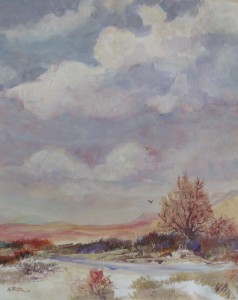
A finished landscape painting or sketch must appear reasonable. It should be convincing in a way that it doesn’t appear as if it’s posing for the artist. The composition will work best if it seems nature remained natural and unaware of being seen or painted by the artist. The contradiction here is that in order for the artist to accomplish this, the subject must be studied with extreme observation.
For an artist to remain aware of plausibility (assuming he/she is a realistic painter), requires an assumption of technical proficiency. They must have an “eye” for the tiniest error that could ruin the credibility for an otherwise well-painted landscape. It is best if they feel something passionate about a scene that compels them to paint it. Otherwise, the painting will conspicuously lack conviction.
Keep in mind, landscape painting is an art form in and of itself. The subject of the painting is often secondary to the main idea. For example, the painting to the left was titled Texas Sky. It was done so simply because the beautiful clouds in the sky covered the bulk of the painting. But the sky is not the total scene. What if we named it Lonely Hawk? After spotting the lone bird in flight, would that make the entire painting any less relevant? No. No matter what subject you wish for this landscape painting, it is secondary to the whole. This is as it should be in a well planned landscape.
